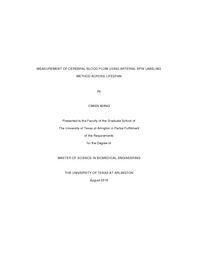
ATTENTION: The works hosted here are being migrated to a new repository that will consolidate resources, improve discoverability, and better show UTA's research impact on the global community. We will update authors as the migration progresses. Please see MavMatrix for more information.
Show simple item record
| dc.contributor.author | Wang, Ciwen | en_US |
| dc.date.accessioned | 2015-12-11T23:20:09Z | |
| dc.date.available | 2015-12-11T23:20:09Z | |
| dc.date.submitted | January 2015 | en_US |
| dc.identifier.other | DISS-13310 | en_US |
| dc.identifier.uri | http://hdl.handle.net/10106/25377 | |
| dc.description.abstract | Arterial Spin Labeling (ASL) is one family of perfusion-weighted contrast imaging techniques of Magnetic Resonance Imaging (MRI) that measures cerebral blood flow by labeling spins in arterial blood with inversion and then waiting for a certain period of time for the labeled arterial blood to enter the imaging plane, and then acquiring MR image at the image plane. In compare with PET, ASL is a noninvasive new technology. But as a new technology, it is not very commonly used because of the relatively low signal to noise ratio, less robust mechanism, and more important, there is no standard for clinical applications. One goal of this study is to find out the optimal imaging processing way and parameters for ASL processing. The other goal is to find the relationship between CBF and age. There are 173 subjects, with 107 female subjects and 66 male subjects.Pseudo-continuous ASL (PCASL) was used as labeling sequence and multi-slice single shot 2D Echo-planar imaging (EPI) was used as MR image acquisition sequence. 40 pairs of control – labeled images were taken in order to increase signal to noise ratio. An MPRAGE T1 image was taken for each subject as brain structure reference. Label duration = 1650ms; post label delay = 1525ms; TR = 4260ms or 4210.8ms; TE=14ms. EPI factor = 35ms. Voxel size = 3×3×5 mm; FOV = 240×240×145 mm; slice number = 29. FSL which is a MRI image processing tool developed by Oxford was used in imaging processing. dcm2nii was used for DICOM to NIFTY conversion. MCFLIRT was used for motion correction. Trilinear interpolation was used in MCFLIRT. In spatial smoothing, a 3D Gaussian kernel with FWHM = 6mm was used. In M0 magnetization baseline calculation, the average magnetization of the whole brain of mean control image was used, so that the T1 recovery time was assumed to be the time from labeling to image acquisition of the middle slice (15th slice). The longitudinal relaxation time of blood was used as T1 value of the tissue. In Cerebral Blood Flow (CBF) calculation, also the longitudinal relaxation time of blood was used as T1 value of the tissue.A threshold of 0 – 300 was used on the CBF map. Voxels below 0 was assigned 0, and above 300 was assigned 300. CBF map was first co-registered on the T1 structural image of the same subject, and then, with the help of the high resolution T1, CBF map was normalized on MNI152 template.Relative CBF map was calculated by dividing the value of each voxel by the mean value of the whole brain CBF. The voxelwise analysis results (p < 0.05) on both CBF and relative CBF show that CBF decline is most significant in prefrontal cortex and the area around the ventricles during aging. CBF of occipital lobe was not affected by aging too much. It is difficult to say if CBF in white matter is not affected by age, or it is the relatively long arterial transit time of white matter that causes this problem. The results of ROI CBF extraction also show that CBF of frontal, prefrontal, temporal cortex and hippocampus, especially right hippocampus has strong negative relationship with aging. CBF of white matter does not affected by aging. | en_US |
| dc.description.sponsorship | Liu, Hanli | en_US |
| dc.language.iso | en | en_US |
| dc.publisher | Biomedical Engineering | en_US |
| dc.title | Measurement Of Cerebral Blood Flow Using Arterial Spin Labeling Method Across Lifespan | en_US |
| dc.type | M.S. | en_US |
| dc.contributor.committeeChair | Liu, Hanli | en_US |
| dc.degree.department | Biomedical Engineering | en_US |
| dc.degree.discipline | Biomedical Engineering | en_US |
| dc.degree.grantor | University of Texas at Arlington | en_US |
| dc.degree.level | masters | en_US |
| dc.degree.name | M.S. | en_US |
Files in this item
- Name:
- Wang_uta_2502M_13310.pdf
- Size:
- 912.7Kb
- Format:
- PDF
This item appears in the following Collection(s)
Show simple item record


